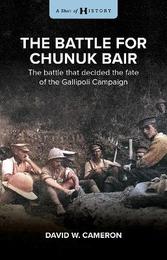
|
The Battle for Chunuk Bair: The battle that decided the fate of the Gallipoli Campaign
Paperback / softback
Main Details
| Title |
The Battle for Chunuk Bair: The battle that decided the fate of the Gallipoli Campaign
|
| Authors and Contributors |
By (author) David W. Cameron
|
| Series | A Shot of History |
|---|
| Physical Properties |
| Format:Paperback / softback | | Pages:224 | | Dimensions(mm): Height 210,Width 153 |
|
| Category/Genre | History
Military history
First world war |
|---|
| ISBN/Barcode |
9781922896261
|
| Audience | |
|---|
|
Publishing Details |
| Publisher |
Big Sky Publishing
|
| Imprint |
Big Sky Publishing
|
| NZ Release Date |
7 June 2023 |
| Publication Country |
Australia
|
Description
The August Offensive or 'Anzac Breakout' at Gallipoli was an attempt to break the stalemate of the campaign. It saw some of the bloodiest fighting since the landing as Commonwealth and Turkish troops fought desperate battles at Lone Pine, German Officers' Trench, Turkish Quinn's, The Chessboard, The Nek, Chunuk Bair, The Farm, Hill Q and Hill 971. The offensive was designed to allow the allied forces to 'break out' of the Anzac beachhead below the Sari Bair Range. The capture of Chunuk Bair, the secondary peak of the Sari Bair range, was one of two objectives to capture. Sever fighting took place across appalling and complex terrain. It was a costly battle however the Anzacs secured their objective. The capture of Chunuk Bair by the was the only success for the Allies of the campaign, but it did not last the position was untenable and the Ottomans recaptured the peak a few days later. The Battle for Chunuk Bair, was one that decided the fate of the Gallipoli Campaign.
Author Biography
David W. Cameron is a Canberra-based author who has written several books on Australian military and convict history, as well as human and primate evolution, including over 60 internationally peer-reviewed papers for various journals and book chapters. He received 1st Class Honours in Prehistoric Archaeology at the University of Sydney and later went on to complete his PhD in palaeoanthropology at the Australian National University. He is a former Australian Research Council (ARC) Post Doctorial Fellow at the Australian National University (School of Archaeology) and an ARC QEII Fellow at the University of Sydney (Department of Anatomy and Histology). He has participated and led several international fieldwork teams in Australia, the Middle East (Turkey, Jordan, Israel, and the United Arab Emirates), Europe (Hungary) and Asia (Japan, Vietnam and India) and has participated in many conferences and museum studies throughout the world.
|